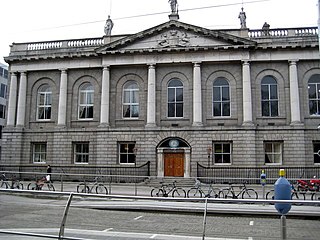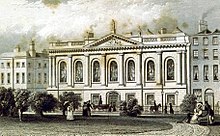
The Royal College of Surgeons in Ireland (RCSI) is a not-for-profit medical professional and educational institution, which is also known as RCSI University of Medicine and Health Sciences. It was established in 1784 as the national body for the surgical branch of medicine in Ireland, with a role in supervision of training, and as of 2021 provides a broad range of medical education in multiple countries.

William Dease (1752?–1798) was an Irish surgeon and anatomist. He was one of the founders of the Royal College of Surgeons in Ireland and its first Professor of Surgery. He studied surgery in Dublin and Paris and was appointed surgeon to the United Hospitals of St Nicholas and St Catherine.

Samuel Croker-King was an Irish surgeon who was associated with Doctor Steevens' Hospital in Dublin for sixty years. He was the first president of the Royal College of Surgeons in Ireland (RCSI), from 1784 to 1785. He is thought to have saved the life of the child who became the Duke of Wellington. He invented his own trepanning device.

John Whiteway was a Dublin surgeon who was the second president of the Royal College of Surgeons in Ireland (RCSI) in 1786.

Philip Woodroffe was the resident surgeon at Dr Steevens' Hospital in Dublin for over 30 years. Several eminent surgeons were apprenticed to him. He was the president of the Royal College of Surgeons in Ireland (RCSI) in 1788.

Ralph Smith O'bré was an Irish physician who was the president of the Royal College of Surgeons in Ireland (RCSI) in 1790. He served as an army surgeon before setting up practice in Dublin where he became wealthy. He invented a popular double tracheostomy tube.

Solomon Richards was an Irish surgeon who served four terms as president of the Royal College of Surgeons in Ireland (RCSI) in 1794, 1803, 1808, and 1818. He achieved fame by performing a tracheotomy in public for which act he featured in a satirical poem in The Metropolis. He was praised for his philanthropy and noted for his puns and bon mots. He was said to be the "fattest surgeon in the United Kingdom".

York Street is a street in Dublin in the Republic of Ireland that runs between Aungier Street in the west and St Stephen's Green in the east.

Gustavus Hume was the president of the Royal College of Surgeons in Ireland (RCSI) in the first part of 1795. He specialised in the diseases of children. He was one of the surgeons who examined the body of the journalist William Jackson after he died from poisoning in a Dublin court in 1795 while awaiting sentencing for high treason.

Clement Archer was a surgeon and president of the Royal College of Surgeons in Ireland (RCSI).

Gerard Macklin was the president of the Royal College of Surgeons in Ireland (RCSI) in 1806.

John Creighton was the president of the Royal College of Surgeons in Ireland (RCSI) in 1812 and 1824.

Patrick Cusack Roney or Rooney was an Irish physician who was President of the Royal College of Surgeons in Ireland (RCSI) in 1814 and 1828.

James Henthorn was the president of the Royal College of Surgeons in Ireland (RCSI) in 1822.

John Timothy Kirby was the president of the Royal College of Surgeons in Ireland (RCSI) in 1823 and 1834.

Alexander Read was the president of the Royal College of Surgeons in Ireland (RCSI) in 1825 and 1835.

Thomas Edward Beatty was an Irish physician, and the president of the Royal College of Surgeons in Ireland (RCSI) in 1850.

James Kerin was an Irish physician who was the president of the Royal College of Surgeons in Ireland (RCSI) in 1833.

Maurice Collis was the president of the Royal College of Surgeons in Ireland (RCSI) in 1839.

Andrew Ellis was the president of the Royal College of Surgeons in Ireland (RCSI) in 1849.






